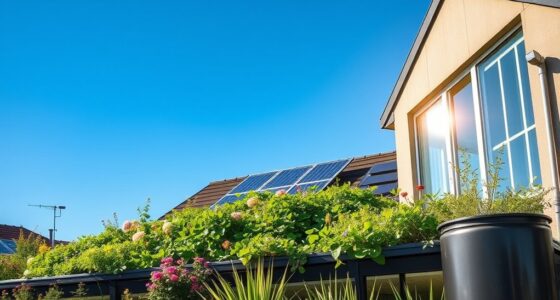Imagine living entirely without relying on mains electricity. It’s a lifestyle that demands careful planning and resourcefulness. While it offers independence and environmental benefits, it also presents unique challenges you must consider. If you’re curious about whether off-grid living could work for you—or how to start making it a reality—there’s more to explore before you decide.
Understanding Off-Grid Living: What Does It Entail?
Understanding off-grid living means embracing a lifestyle that operates independently of public utilities like water, electricity, and sewer systems. You take control of your resources, relying on self-sufficient solutions to meet daily needs. This lifestyle often involves collecting rainwater or sourcing water from nearby wells, managing waste through composting or septic systems, and generating your own power. It requires planning and adapting to your environment, including managing energy, water, and waste without municipal support. To optimize efficiency and sustainability, many off-grid dwellers utilize AI-powered tools to monitor and manage their resources more effectively. Off-grid living isn’t just about disconnecting; it’s about creating a sustainable, resilient way of life that minimizes dependence on external infrastructure. You become more aware of your resource consumption and develop skills to maintain your home and environment. It’s a conscious choice for freedom, simplicity, and environmental responsibility.
Essential Power Sources for Off-Grid Homes
When living off-grid, your power sources are essential to maintaining independence and ensuring your daily needs are met. Solar panels are popular because they’re reliable and renewable, harnessing sunlight to generate electricity.
Wind turbines can supplement solar power, especially if you live in a windy area, providing a consistent energy source.
You might also consider micro-hydro systems if you have access to flowing water, offering a steady supply of power.
In some cases, backup generators are necessary for cloudy days or periods of low sunlight.
Combining these sources creates a resilient energy system, reducing reliance on external power and increasing your self-sufficiency.
Each option has its strengths, so choosing the right mix depends on your location, climate, and energy demands. For optimal performance, understanding power source technology can help you make informed decisions about your off-grid energy setup.
Benefits and Challenges of Going Off-Grid
Choosing to go off-grid offers the freedom to live independently and reduce reliance on utility companies, but it also comes with both significant benefits and notable challenges. One major benefit is the opportunity for self-sufficiency, saving money on energy bills, and minimizing your environmental impact.
You gain control over your energy sources and can tailor your system to your needs. However, challenges include the initial setup costs, ongoing maintenance, and the need for reliable backup plans during bad weather or system failures.
You’ll also need to be prepared for a learning curve, as managing your energy system requires ongoing attention. While off-grid living promotes sustainability and independence, it demands commitment, resourcefulness, and careful planning to ensure a smooth experience.
Considering solar energy solutions can help optimize your off-grid setup and increase your energy resilience.
Assessing Your Energy Needs and Feasibility
Before you can determine if going off-grid is practical, you need to accurately assess your energy needs. Start by listing all the electrical devices you use daily, from lighting and appliances to electronics. Note their wattage and estimate how many hours each runs daily. This helps you calculate your total daily energy consumption in watt-hours or kilowatt-hours.
Consider seasonal variations—heating in winter or cooling in summer can significantly change your energy requirements. Once you have a clear picture of your consumption, evaluate the feasibility of meeting that demand with available renewable resources like solar, wind, or hydropower.
Understanding your lifestyle habits and energy patterns can also influence your off-grid setup, ensuring your system is tailored to your specific needs. Keep in mind that your location, climate, and budget influence what’s achievable. This assessment forms the foundation for deciding whether off-grid living is a realistic and sustainable option for you.
Practical Tips for Transitioning to Off-Grid Power
Transitioning to off-grid power requires careful planning and a proactive approach. Start by evaluating your energy needs to determine the size of your system.
Invest in high-quality solar panels or wind turbines suited to your location, and consider battery storage to ensure power during cloudy days or calm periods.
Reduce energy consumption by upgrading appliances and adopting efficient habits.
Install a backup generator for emergencies, and set up a simple monitoring system to track your energy usage and system performance.
Keep maintenance manageable by scheduling regular inspections of your equipment.
Educate yourself on safety procedures, especially when handling batteries and electrical components.
Understanding renewable energy sources can help you optimize your off-grid setup and maximize sustainability.
With thorough planning, you’ll create a reliable, sustainable off-grid power setup that supports your lifestyle.
Is Off-Grid Living Right for You?
Ever wondered if off-grid living suits your lifestyle and goals? You need to assess your mindset and daily routines. Do you enjoy independence and self-sufficiency?
Off-grid living demands adaptability and a willingness to handle challenges like managing energy, water, and waste. If you value modern conveniences and quick fixes, it mightn’t be the right fit.
Consider your comfort with manual labor, maintenance, and unpredictable power sources. Financially, it can save money long-term, but initial setup costs are high.
Think about your community ties—off-grid living often means remote locations. If you crave solitude, resilience, and a sustainable lifestyle, it could be a great match.
Ultimately, honesty about your priorities will help determine if living off-grid aligns with your vision. Additionally, understanding the essential equipment needed for sound recording can be crucial if you plan to document your journey or create content remotely.
Conclusion
Living off-grid is a rewarding challenge that requires careful planning, resourcefulness, and commitment. If you’re ready to embrace sustainability and independence, it can significantly reduce your environmental impact and save you money in the long run. But make sure you honestly assess your needs and resources first. With the right mindset and preparation, you can thrive without mains electricity and enjoy a more self-sufficient, eco-friendly lifestyle.






